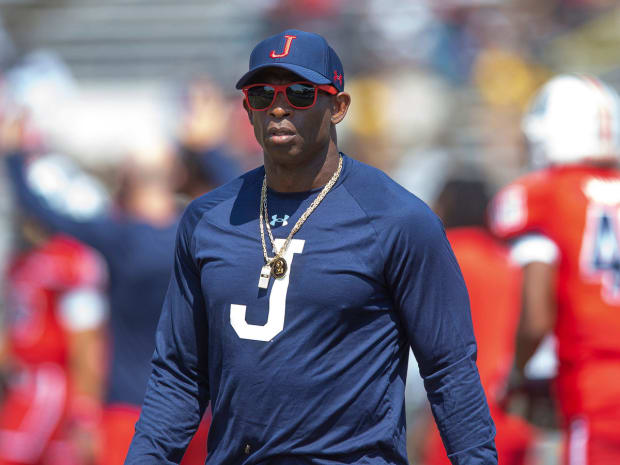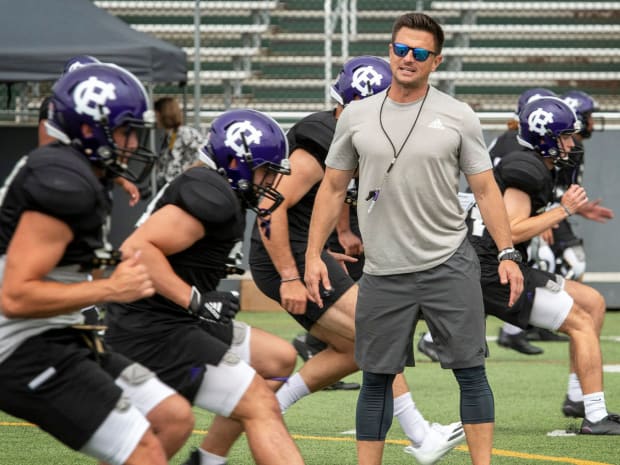JSU’s Deion Sanders and Holy Cross’s Bob Chesney are among the lower-level coaches who could be candidates to make the jump.
College football programs pull coaches from many different places. There are the conventional routes, like poaching a sitting FBS coach or sticking with an interim or hiring a coordinator. Schools have gotten a bit creative in the last few years, like Texas Tech hiring Baylor assistant coach Joey McGuire or Arkansas hiring Georgia offensive line coach Sam Pittman. There was also North Carolina running it back with Mack Brown, who was 68 when the Tar Heels hired him for the second time. But it has been four coaching cycles since the last time an FBS team hired a coach directly from a lower level.
Following the 2018 regular season, three were hired: at East Carolina (Mike Houston, from then-FCS James Madison), Kansas State (Chris Klieman, from North Dakota State) and Charlotte (Will Healy, from Austin Peay). Klieman’s hire has unquestionably been a success, although it certainly raised eyebrows at the time as he followed legend Bill Snyder. The 55-year-old has maintained stability for the Wildcats and kept them in Big 12 contention. Houston earned a 7–5 record in 2021 and is 6–3 in ’22. Healy was unable to deliver in the win column and was fired with four games left in ’22. The question as the coaching cycle heats up is if an FBS program will take a look at the FCS level this year even though the highest level of the sport has never looked different?
Consider how seismic it would feel if one of the bluest of bluebloods hired an FCS coach today. That’s exactly what happened in 2001 when Jim Tressel was hired by Ohio State from (then Division I-AA) Youngstown State. The Buckeyes were in their version of a bad way after going 6–6 in 1999 (the program’s third .500 or below record since ’47) and 8–4 in 2000. John Cooper got the program away from its Woody Hayes era ties in 1988 when he was hired, but he was 2-10-1 against hated Michigan, and that cardinal sin damned his tenure.
So Ohio State looked in-state to a former assistant coach who had left the program to take a $2,000 pay cut and coach Youngstown State in 1985. All Tressel’s Penguins had done was win four national titles and play in two more championship games. His success in Columbus was almost immediate, winning the national championship in 2002 and playing in back-to-back title games in ’06 and ’07. But does Tressel think someone can pull the same move he did?
“I think it would have to be a perfect storm,” says Tressel, now the president at Youngstown State. “Because there’s just so much media attention on pizzazz. And I always tell our people here, whether we’re hiring a dean or a provost or whatever, I don’t want to win the press conference. I want to win the game. And I don’t care what it sounds like on the way in. But let’s have someone come here that can really win for us. And it would take that type of thinking. Because right now, I think people are so caught up in what will this hire sound like?”

Barbara Gauntt/USA TODAY NETWORK
Tressel is quick to remind that he isn’t the only FCS coach to move up and have immense success. Frank Beamer went from Murray State to Virginia Tech in 1986 and became a beacon of stability. He also pointed toward “the young fellow over at Kansas State” who’s “doing ok.” The thing that unites both men is dominating at the FCS level before coming up. Klieman coached North Dakota State to four national championships in five years.
Before Kleiman’s move to K-State, an FCS coach hadn’t moved to the Power 5 since Jim Harbaugh went from San Diego to Stanford, largely by selling decision-makers on being the maniacal recruiter that could handle the task of criss-crossing the nation to chase the type of athlete that was both Pac-12 caliber and could get into the school. But Tressel moved up to an FBS that was simply more quaint relative to the pseudo-professional game it is today. For instance, Youngstown State’s current coach Doug Phillips makes $250,000 a year. If Ohio State wide receiver coach Brian Hartline were to make the same move Tressel did in 1986, he’d be costing himself $700,000.
Money matters even more so because the programs an FCS coach would most likely jump to are in the Group of 5. Budget crunches are all over the G5 as teams try to compete in an increasingly professionalized landscape.
“There’s Nick Sabans of the world that bring incredible value and now have even brought incredible value from a stability perspective because basically the offense is his, the defense is his and the special teams is his, so no matter who’s in there coordinating, it’s his stuff,” Healy says. “That’s why he’s maybe the best to ever do it. But for me, I can hire coaches who can call plays better than I can. I can hire really good position coaches that can go help schematically and recruit, do all those things.
“Where I felt like I brought value was getting a city wrapped around an athletic program and being able to go raise money where I could keep coaches and being able to go raise money where we could operate like we needed to operate in this league and I never wavered from that.”
Healy was hired by Charlotte after three seasons at Austin Peay where he went 0–11, 8–4 and 5–6 in consecutive years. The 49ers initially tried to hire Houston, who decided at the 11th hour to go to ECU. Charlotte has been an FBS program since only 2015, when the first coach in the program’s modern history, Brad Lambert, brought them up from a two-year stint as an FCS independent. The program has moved quickly and is headed from Conference USA to the American in ’23.
Healy played to his personal strengths when taking the job, and then everything changed when the COVID-19 pandemic brought on a challenging 2020 season when the 49ers had seven straight games canceled. Then the NIL era began.
“The initial job was the job I had at Austin Peay on a different scale. The job has changed drastically since the [creation of the] portal and NIL,” Healy says. “The $2.5 to $3 million a year that you need to catch up from a budget perspective needs to also go to players. I mean, you’re $3 million off on an operating budget in Conference USA, and now you’re $6 million off.”
These are issues all Group of 5 coaches have to deal with, and Healy was clear that he knows he didn’t win enough. But it goes to show that when it doesn’t work, the same things that can sink a coach from the FCS can sink seasoned veteran coaches.
“There’s more good coaches than there are good jobs,” Tressel says.
Acquiring and developing players is what sets some of the next likeliest FCS-to-FBS movers apart. As USF looks to replace coach Jeff Scott, FAMU’s Willie Simmons will likely be on their radar, just as he was for FIU in its most recent coaching search as a Florida native. At some point, Jackson State’s Deion Sanders may move up to the next level. He told 60 Minutes:
“I’m gonna have to entertain [Power 5 job offers] … Yes, I’m gonna have to entertain it. Straight up. I would be a fool not to.”

Rick Cinclair/Telegram & Gazette/USA TODAY Network
Those Power 5 offers are expected to indeed keep coming after Sanders was involved in the search process at TCU last cycle. He might just be one of the perfect storm cases Tressel mentioned as someone who can recruit and navigate the NIL era. He may even end up being a portal package deal with highly touted freshman DB Travis Hunter and his son, QB Shedeur Sanders. But he’s also not terribly representative of FCS coaches writ large as a force of nature personality-wise whose individual stardom would eclipse the notoriety of even most FBS programs. But Sanders is more than the hype, as those who have been around him point to his organization and ability to operate as a modern CEO coach. His Tigers went 11–2 in 2021 and have started the ’22 season going 8–0.
Similarly undefeated are the Holy Cross Crusaders, at 9–0 after a 10–3 2021 season. They’re coached by Bob Chesney, who has now won at three levels of college football with a conference championship at Salve Regina (Division III) and two at Assumption (D-II). He’s now clinched his fourth Patriot League title with Holy Cross.
A key to developing players for Chesney is a focus on special teams—similar to Beamer’s trademark Beamer Ball. At Assumption, kicker Cole Tracy graduated and transferred to LSU, where he became a second-team All-American. And returner Deonte Harty set the NCAA record (regardless of division) for touchdown returns by a specialist. He is now a contributor for the Saints after entering the NFL undrafted. Chesney has brought the mindset to Holy Cross, which is second in FBS in blocked kicks and punts and has now beaten an FBS team in consecutive years (UConn in 2021, Buffalo in ’22).
“It’s not just offense; it’s not just defense; it’s a little bit of everybody,” Chesney says. “And honestly, probably the most important thing about special teams, the fundamentals that they will learn. The fundamentals of blocking, the fundamentals of getting off of a block. Angles, pursuit, just overall toughness. And then, speed and aggressiveness.”
Special teamers eat first, which is a hallmark of other programs that pride themselves on that phase of the game—like Urban Meyer’s Florida and Ohio State teams. Starters play special teams, too, and how a player will factor on one of the special teams units goes into how Holy Cross recruits athletes.
There is more than just the physical part of an athlete’s makeup, and as college athletes raise mental health concerns at an elevated rate since the pandemic began, Chesney’s program attempts to tackle that issue with what he calls the team’s “mental strength coach,” sports psychologist Trevor Cote, who works in the school’s counseling center assisting athletes. Chesney will consult Cote on his own and have him come speak to the team during camp and in-season. It’s changed how the Crusaders have handled situations beyond just wins and losses and what happens during games, like how injured players are treated and helping them feel like they’re still part of the program even if they aren’t contributing on game days.
Chesney bristles at media attention on him by nature, saying he’s still getting comfortable with that part of the job. He likely won’t make a Tressel-sized leap, but could be one of multiple FCS coaches this cycle who could be under consideration to take a step up.
More College Football Coverage:
• Tulane’s Near-Miraculous Turnaround Almost Didn’t Happen
• The Most Fed-Up Fan Bases in College Football
• Sanders Lobbies for Jackson State FBS Bowl Berth